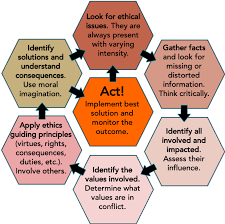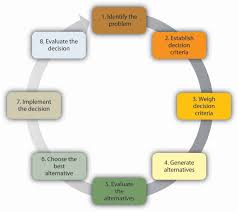5 Essential Tips for Effective Decision-Making Tools
- Use a decision-making framework to structure your process.
- Gather as much data as possible to inform your decisions.
- Consider using a decision matrix or other analytical tools to help you weigh the pros and cons of each option.
- Make sure to include stakeholders in the decision-making process, so they can provide input and perspective on potential solutions.
- Take time to reflect on the possible outcomes of each choice before making a final decision.
Use a decision-making framework to structure your process.
When it comes to making important decisions, having a structured process can make all the difference. This is where decision-making frameworks come in handy. A decision-making framework is a structured approach that helps you organize your thoughts and prioritize your options. It can help you identify the key factors that are important to consider and weigh the pros and cons of each option.
There are many different types of decision-making frameworks available, but they all share a common goal: to help you make better decisions. One popular framework is called the “Pros and Cons” method, which involves creating a list of advantages and disadvantages for each option. Another framework is called the “Decision Matrix,” which involves assigning scores to different options based on their importance and evaluating them against each other.
Using a decision-making framework can also help you avoid common pitfalls such as analysis paralysis or making decisions based solely on emotions or biases. By following a structured process, you can ensure that you have considered all relevant information and have made an informed decision.
In conclusion, using a decision-making framework can be an effective tool for structuring your thought process when making important decisions. By organizing your thoughts and weighing the pros and cons of each option, you can make more informed decisions that are less likely to be influenced by emotions or biases. So next time you’re faced with an important decision, consider using a decision-making framework to guide your thought process!
Gather as much data as possible to inform your decisions.
When it comes to making decisions, it’s important to gather as much data as possible before making a choice. Data can come in many forms, such as research studies, surveys, feedback from others, and personal experiences. By gathering this information, you can make informed decisions that are based on facts rather than assumptions or guesswork.
One of the benefits of gathering data is that it helps to reduce uncertainty. When you have more information at your disposal, you can better understand the potential outcomes of your decision and evaluate the risks involved. This allows you to make more informed choices that are aligned with your goals and values.
Another advantage of gathering data is that it helps to avoid biases. Our brains are wired to make quick judgments based on limited information, which can lead to errors in decision making. By gathering a broad range of data from different sources, we can overcome these biases and make more objective decisions.
Of course, gathering data is not always easy or straightforward. It requires time and effort to find relevant information and analyze it effectively. However, the benefits of doing so far outweigh the costs in terms of improved decision making.
In conclusion, if you want to improve your decision-making skills, start by gathering as much data as possible before making a choice. With this approach, you’ll be able to make informed decisions that are based on facts rather than assumptions or biases.
Consider using a decision matrix or other analytical tools to help you weigh the pros and cons of each option.
When it comes to making important decisions, it can be difficult to keep track of all the factors at play. That’s where decision-making tools like a decision matrix come in handy. A decision matrix is a simple tool that helps you weigh the pros and cons of each option by assigning scores to different criteria.
To use a decision matrix, start by listing all of your options and the criteria that are important to you. Then, assign each criterion a weight based on how important it is to you. Next, rate each option on each criterion using a scale of 1-10 (or any other scale that works for you). Finally, multiply the rating by the weight for each criterion and add up the scores for each option. The option with the highest score is likely your best choice.
Other analytical tools like SWOT analysis or Pareto analysis can also be helpful in decision making. SWOT analysis helps you identify strengths, weaknesses, opportunities, and threats associated with each option while Pareto analysis helps you identify which factors are most important in making your decision.
By using these tools, you can make more informed decisions and feel confident that you’ve considered all relevant factors before making your choice. So next time you’re faced with an important decision, consider using a decision matrix or other analytical tool to help make the process easier and more effective.
Make sure to include stakeholders in the decision-making process, so they can provide input and perspective on potential solutions.
Effective decision making is a crucial aspect of any successful organization. However, it can be challenging to make decisions that will benefit everyone involved. One of the most important tools for making informed decisions is to involve stakeholders in the process.
Stakeholders are individuals or groups who have a vested interest in the outcome of a decision. They may include employees, customers, suppliers, or shareholders. By involving stakeholders in the decision-making process, you can gain valuable insights and perspectives on potential solutions.
When stakeholders are involved in the decision-making process, they feel heard and valued. This can increase their commitment to the organization and help build trust among team members. Additionally, involving stakeholders can help identify potential issues or roadblocks that may not have been considered otherwise.
However, it’s important to note that involving stakeholders does not mean that every opinion must be taken into account. It’s essential to balance feedback with sound reasoning and expertise when making decisions.
In conclusion, involving stakeholders in the decision-making process is an essential tool for making informed decisions. By doing so, you can gain valuable insights and perspectives that may have been overlooked otherwise. It’s important to remember that while stakeholder input is valuable, it should be balanced with sound reasoning and expertise when making final decisions.
Take time to reflect on the possible outcomes of each choice before making a final decision.
Making decisions can be a challenging and stressful process, especially when you are faced with multiple options. However, taking the time to reflect on the possible outcomes of each choice before making a final decision can help alleviate some of that stress and make the decision-making process smoother.
Reflecting on the possible outcomes of each choice allows you to weigh the pros and cons of each option. It gives you the opportunity to consider both short-term and long-term consequences of your decision. This reflection can help you identify potential risks or benefits that may not have been immediately apparent.
When reflecting on possible outcomes, it is important to consider all factors that may impact your decision. This includes personal values, emotions, financial considerations, and any other relevant information. By taking all of these factors into account, you can make a more informed decision that aligns with your goals and priorities.
Taking time to reflect also helps prevent impulsive decisions based solely on emotion or external pressures. It allows you to step back from the situation and approach it with a clear mind.
In conclusion, taking time to reflect on possible outcomes before making a final decision is an essential tool for effective decision making. It helps you consider all relevant factors and make an informed choice that aligns with your goals and values. So next time you are faced with a difficult decision, take a step back and reflect before making your final choice.



